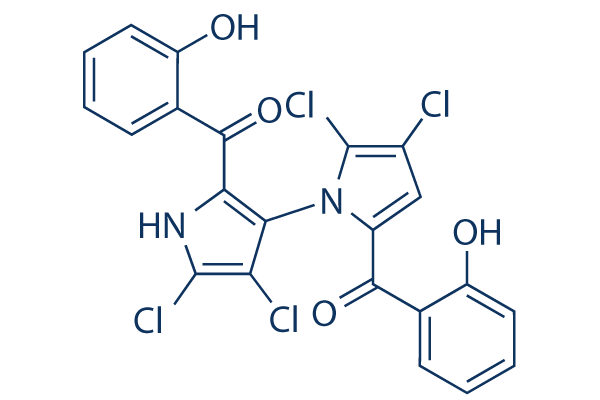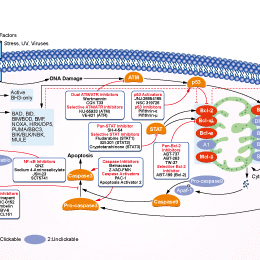
- Bioactive Compounds
- By Signaling Pathways
- PI3K/Akt/mTOR
- Epigenetics
- Methylation
- Immunology & Inflammation
- Protein Tyrosine Kinase
- Angiogenesis
- Apoptosis
- Autophagy
- ER stress & UPR
- JAK/STAT
- MAPK
- Cytoskeletal Signaling
- Cell Cycle
- TGF-beta/Smad
- DNA Damage/DNA Repair
- Compound Libraries
- Popular Compound Libraries
- Customize Library
- Clinical and FDA-approved Related
- Bioactive Compound Libraries
- Inhibitor Related
- Natural Product Related
- Metabolism Related
- Cell Death Related
- By Signaling Pathway
- By Disease
- Anti-infection and Antiviral Related
- Neuronal and Immunology Related
- Fragment and Covalent Related
- FDA-approved Drug Library
- FDA-approved & Passed Phase I Drug Library
- Preclinical/Clinical Compound Library
- Bioactive Compound Library-I
- Bioactive Compound Library-Ⅱ
- Kinase Inhibitor Library
- Express-Pick Library
- Natural Product Library
- Human Endogenous Metabolite Compound Library
- Alkaloid Compound LibraryNew
- Angiogenesis Related compound Library
- Anti-Aging Compound Library
- Anti-alzheimer Disease Compound Library
- Antibiotics compound Library
- Anti-cancer Compound Library
- Anti-cancer Compound Library-Ⅱ
- Anti-cancer Metabolism Compound Library
- Anti-Cardiovascular Disease Compound Library
- Anti-diabetic Compound Library
- Anti-infection Compound Library
- Antioxidant Compound Library
- Anti-parasitic Compound Library
- Antiviral Compound Library
- Apoptosis Compound Library
- Autophagy Compound Library
- Calcium Channel Blocker LibraryNew
- Cambridge Cancer Compound Library
- Carbohydrate Metabolism Compound LibraryNew
- Cell Cycle compound library
- CNS-Penetrant Compound Library
- Covalent Inhibitor Library
- Cytokine Inhibitor LibraryNew
- Cytoskeletal Signaling Pathway Compound Library
- DNA Damage/DNA Repair compound Library
- Drug-like Compound Library
- Endoplasmic Reticulum Stress Compound Library
- Epigenetics Compound Library
- Exosome Secretion Related Compound LibraryNew
- FDA-approved Anticancer Drug LibraryNew
- Ferroptosis Compound Library
- Flavonoid Compound Library
- Fragment Library
- Glutamine Metabolism Compound Library
- Glycolysis Compound Library
- GPCR Compound Library
- Gut Microbial Metabolite Library
- HIF-1 Signaling Pathway Compound Library
- Highly Selective Inhibitor Library
- Histone modification compound library
- HTS Library for Drug Discovery
- Human Hormone Related Compound LibraryNew
- Human Transcription Factor Compound LibraryNew
- Immunology/Inflammation Compound Library
- Inhibitor Library
- Ion Channel Ligand Library
- JAK/STAT compound library
- Lipid Metabolism Compound LibraryNew
- Macrocyclic Compound Library
- MAPK Inhibitor Library
- Medicine Food Homology Compound Library
- Metabolism Compound Library
- Methylation Compound Library
- Mouse Metabolite Compound LibraryNew
- Natural Organic Compound Library
- Neuronal Signaling Compound Library
- NF-κB Signaling Compound Library
- Nucleoside Analogue Library
- Obesity Compound Library
- Oxidative Stress Compound LibraryNew
- Plant Extract Library
- Phenotypic Screening Library
- PI3K/Akt Inhibitor Library
- Protease Inhibitor Library
- Protein-protein Interaction Inhibitor Library
- Pyroptosis Compound Library
- Small Molecule Immuno-Oncology Compound Library
- Mitochondria-Targeted Compound LibraryNew
- Stem Cell Differentiation Compound LibraryNew
- Stem Cell Signaling Compound Library
- Natural Phenol Compound LibraryNew
- Natural Terpenoid Compound LibraryNew
- TGF-beta/Smad compound library
- Traditional Chinese Medicine Library
- Tyrosine Kinase Inhibitor Library
- Ubiquitination Compound Library
-
Cherry Picking
You can personalize your library with chemicals from within Selleck's inventory. Build the right library for your research endeavors by choosing from compounds in all of our available libraries.
Please contact us at [email protected] to customize your library.
You could select:
- Antibodies
- Bioreagents
- qPCR
- 2x SYBR Green qPCR Master Mix
- 2x SYBR Green qPCR Master Mix(Low ROX)
- 2x SYBR Green qPCR Master Mix(High ROX)
- Protein Assay
- Protein A/G Magnetic Beads for IP
- Anti-Flag magnetic beads
- Anti-Flag Affinity Gel
- Anti-Myc magnetic beads
- Anti-HA magnetic beads
- Magnetic Separator
- Poly DYKDDDDK Tag Peptide lyophilized powder
- Protease Inhibitor Cocktail
- Protease Inhibitor Cocktail (EDTA-Free, 100X in DMSO)
- Phosphatase Inhibitor Cocktail (2 Tubes, 100X)
- Cell Biology
- Cell Counting Kit-8 (CCK-8)
- Animal Experiment
- Mouse Direct PCR Kit (For Genotyping)
- New Products
- Contact Us
Marinopyrrole A (Maritoclax)
Marinopyrrole A (Maritoclax) is a selective Mcl-1 antagonist. It binds to Mcl-1, but not Bcl-XL, and targets Mcl-1 for proteasomal degradation. Maritoclax disrupts the interaction between Bim and Mcl-1 with an IC50 of 10.1 μM.

Marinopyrrole A (Maritoclax) Chemical Structure
CAS No. 1227962-62-0
Purity & Quality Control
Batch:
Purity:
99.66%
99.66
Marinopyrrole A (Maritoclax) Related Products
| Related Targets | Bcl-2 Bcl-B Bcl-w Bcl-xL Mcl-1 Bax Bfl-1 Bad Bcl-xL | Click to Expand |
|---|---|---|
| Related Products | ABT-737 Navitoclax (ABT-263) Obatoclax Mesylate (GX15-070) S63845 A-1210477 TW-37 A-1331852 A-1155463 Dihydrochloride UMI-77 AZD5991 (R)-(-)-Gossypol (AT-101) acetic acid Sabutoclax WEHI-539 HA14-1 MIK665 (S64315) Obatoclax (GX15-070) Gambogic Acid BAI1 A-1155463 BTSA1 S55746 Ruxotemitide (LTX 315) BAM7 BDA-366 | Click to Expand |
| Related Compound Libraries | Autophagy Compound Library Apoptosis Compound Library Ferroptosis Compound Library Pyroptosis Compound Library Mitochondria-Targeted Compound Library | Click to Expand |
Signaling Pathway
Biological Activity
| Description | Marinopyrrole A (Maritoclax) is a selective Mcl-1 antagonist. It binds to Mcl-1, but not Bcl-XL, and targets Mcl-1 for proteasomal degradation. Maritoclax disrupts the interaction between Bim and Mcl-1 with an IC50 of 10.1 μM. | |
|---|---|---|
| Targets |
|
| In vitro | ||||
| In vitro | Maritoclax induces Mcl-1 degradation via the proteasome system, which is associated with the pro-apoptotic activity of maritoclax. Maritoclax selectively kills Mcl-1-dependent, but not Bcl-2- or Bcl-XL-dependent, leukemia cells and markedly enhances the efficacy of ABT-737 against hematologic malignancies, including K562, Raji, and multidrug-resistant HL60/VCR, by ∼60- to 2000-fold at 1-2 μM. Maritoclax blocks the interaction between a biotin-labeled Bim-BH3 peptide and GST-Mcl-1 in a dose-dependent manner with an IC50 value of 10.1 μM, while it does not inhibit the binding of Bim-BH3 peptide to GST-Bcl-XL at concentrations up to 80 μM. Maritoclax induces caspase-3 activation by degradation of Mcl-1 protein. Treatment with maritoclax markedly reduces the half-life of Mcl-1 to ∼0.5 h as compared with nearly 3 h in control cells. Maritoclax has no apparent effect on Mcl-1 (Ser159/Thr163) phosphorylation, suggesting that maritoclax induces phosphorylation-independent Mcl-1 degradation[1]. Marinopyrrole A has potent concentration-dependent bactericidal activity against clinically relevant hospital- and community-acquired MRSA strains. Marinopyrrole A shows limited toxicity to mammalian cell lines (at >20× MIC)[2]. Maritoclax sensitivity is cell type specific. It is not effective in HeLa, HEK293, or MEF cells. Maritoclax is not a substrate for p-gp mediated drug efflux[3]. | |||
|---|---|---|---|---|
| Cell Research | Cell lines | K562 cells | ||
| Concentrations | 2 μM | |||
| Incubation Time | 12 h | |||
| Method | K562 cells expressing Mcl-1-IRES-BimEL are treated with DMSO, 2 μM maritoclax alone, or in combination with 1 μM MG132 for 12 h. Cells are lysed in 1% Chaps buffer (1% Chaps, 150 mM NaCl, 10 mM Hepes, pH7.4) containing protease inhibitors. Cell lysates containing 350 μg of protein are incubated with 4 μl of rabbit anti-Mcl-1 antiserum or control pre-immune serum in 250 μl of the same lysis buffer at 4 °C overnight on a rotator. Immunoprecipitates are collected by adding 20 μl of protein A-Sepharose beads for 3 h at 4 °C, followed by centrifugation at 6,000 rpm for 30 s. The beads are washed five times with the same lysis buffer, boiled for 5 min in Laemmli sample buffer and analyzed by Western blotting. |
|||
| In Vivo | ||
| In vivo | Maritoclax administration at 20 mg/kg/d intraperitoneally causes significant U937 tumor shrinkage, as well as 36% tumors remission rate in athymic nude mice, without apparent toxicity to healthy tissue or circulating blood cells[3]. | |
|---|---|---|
| Animal Research | Animal Models | Female athymic nude (NCI Athymic NCr-nu/nu 01B74) mice |
| Dosages | 20 mg/kg | |
| Administration | i.p. | |
Chemical Information & Solubility
| Molecular Weight | 510.15 | Formula | C22H12Cl4N2O4 |
| CAS No. | 1227962-62-0 | SDF | Download Marinopyrrole A (Maritoclax) SDF |
| Smiles | C1=CC=C(C(=C1)C(=O)C2=CC(=C(N2C3=C(NC(=C3Cl)Cl)C(=O)C4=CC=CC=C4O)Cl)Cl)O | ||
| Storage (From the date of receipt) | |||
|
In vitro |
DMSO : 100 mg/mL ( (196.02 mM) Moisture-absorbing DMSO reduces solubility. Please use fresh DMSO.) Ethanol : 59 mg/mL Water : Insoluble |
Molecular Weight Calculator |
|
In vivo Add solvents to the product individually and in order. |
In vivo Formulation Calculator |
||||
Preparing Stock Solutions
Molarity Calculator
In vivo Formulation Calculator (Clear solution)
Step 1: Enter information below (Recommended: An additional animal making an allowance for loss during the experiment)
mg/kg
g
μL
Step 2: Enter the in vivo formulation (This is only the calculator, not formulation. Please contact us first if there is no in vivo formulation at the solubility Section.)
% DMSO
%
% Tween 80
% ddH2O
%DMSO
%
Calculation results:
Working concentration: mg/ml;
Method for preparing DMSO master liquid: mg drug pre-dissolved in μL DMSO ( Master liquid concentration mg/mL, Please contact us first if the concentration exceeds the DMSO solubility of the batch of drug. )
Method for preparing in vivo formulation: Take μL DMSO master liquid, next addμL PEG300, mix and clarify, next addμL Tween 80, mix and clarify, next add μL ddH2O, mix and clarify.
Method for preparing in vivo formulation: Take μL DMSO master liquid, next add μL Corn oil, mix and clarify.
Note: 1. Please make sure the liquid is clear before adding the next solvent.
2. Be sure to add the solvent(s) in order. You must ensure that the solution obtained, in the previous addition, is a clear solution before proceeding to add the next solvent. Physical methods such
as vortex, ultrasound or hot water bath can be used to aid dissolving.
Tech Support
Answers to questions you may have can be found in the inhibitor handling instructions. Topics include how to prepare stock solutions, how to store inhibitors, and issues that need special attention for cell-based assays and animal experiments.
Tel: +1-832-582-8158 Ext:3
If you have any other enquiries, please leave a message.
* Indicates a Required Field
Tags: buy Marinopyrrole A (Maritoclax) | Marinopyrrole A (Maritoclax) supplier | purchase Marinopyrrole A (Maritoclax) | Marinopyrrole A (Maritoclax) cost | Marinopyrrole A (Maritoclax) manufacturer | order Marinopyrrole A (Maritoclax) | Marinopyrrole A (Maritoclax) distributor







































